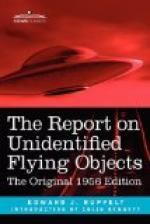I missed my Dayton flight but I heard a good UFO story.
What had the two pilots and their passenger seen? We kicked it around plenty that afternoon. It was no balloon. It wasn’t another airplane because when the pilot called Kirksville Radio he’d asked if there were any airplanes in the area. It might possibly have been a reflection of some kind except that when it “sank” into the overcast the pilot said it looked like something sinking into an overcast—it just didn’t disappear as a reflection would. Then there was the sudden reappearance off the right wing. These are the types of things you just can’t explain.
What did the pilots think it was? Three were sold that the UFO’s were interplanetary spacecraft, one man was convinced that they were some U.S. “secret weapon,” and three of the men just shook their heads. So did I. We all agreed on one thing—this pilot had seen something and it was something highly unusual.
The meeting broke up about 9:00P.M. I’d gotten the personal and very candid opinion of seven airline captains, and the opinions of half a hundred more airline pilots had been quoted. I’d learned that the UFO’s are discussed often. I’d learned that many airline pilots take UFO sightings very seriously. I learned that some believe they are interplanetary, some think they’re a U.S. weapon, and many just don’t know. But very few are laughing off the good sightings.
By May 1950 the flying saucer business had hit a new all-time peak.
The Air Force didn’t take any side, they just shrugged. There was no attempt to investigate and explain the various sightings. Maybe this was because someone was afraid the answer would be “Unknown.” Or maybe it was because a few key officers thought that the eagles or stars on their shoulders made them leaders of all men. If they didn’t believe in flying saucers and said so, it would be like calming the stormy Sea of Galilee. “It’s all a bunch of damned nonsense,” an Air Force colonel who was controlling the UFO investigation said. “There’s no such thing as a flying saucer.” He went on to say that all people who saw flying saucers were jokers, crackpots, or publicity hounds. Then he gave the airline pilots who’d been reporting UFO’s a reprieve. “They were just fatigued,” he said. “What they thought were spaceships were windshield reflections.”
This was the unbiased processing of UFO reports through normal intelligence channels.
But the U.S. public evidently had more faith in the “crackpot” scientists who were spending millions of the public’s dollars at the White Sands Proving Grounds, in the “publicity-mad” military pilots, and the “tired, old” airline pilots, because in a nationwide poll it was found that only 6 per cent of the country’s 150,697,361 people agreed with the colonel and said, “There aren’t such things.”
Ninety-four per cent had different ideas.




